Outline
- Scope.
- Packages
- Comments and Javadoc.
Source Program Structure
- Java source comprises one or more source files.
- A source file is your basic text file.
- The filename should have a
.java extension.
- Each source file contains one or more class defintions (among other
things).
- Each class in a source file compiles in to a separate
.class file.
Executable Structure
- The JVM builds an executible from
.class files.
-
.class files are loaded at runtime as needed.
- This is known as lazy link and load.
- This is an amazingly powerful and dangerous feature.
- Unfortunately, we won't be persuing it in this class.
Compilation
- The
javac compiler also deals with .class files.
- It needs them for type checking, for example.
- The compiler manages source-
.class file consistency automatically.
- Newer source files are compiled to update older (or nonexistent)
.class files.
Development Structure
- What kind of development structure works well with Java?
- The trick here is there are two set of files: the source and the
.class files.
- One possibility is a monolithic structure: all files in one place.
Monolithic Problems
- Monoliths are not well structured, and so don't scale well and are
difficult to deal with.
- Break monoliths up into interacting pieces.
- Functional division is usually the best, but there are other ways.
- The result is a set of mini-monoliths.
- But each new monolith is smaller and functionally consistent.
Packages
- A package is
a named group
of
.class files.
- Every
.class file is a member of exactly one package.
- A source file declares package membership with a
package
statement:
package package-name;
- Every
.class file created from the source file belongs to the
declared package.
Accessing Classes
Class Access
- Package qualification indicates class package membership.
board.TetrisBoard board;
- The TetrisBoard
.class file in the board package.
- You tell the compiler (and the JVM) the package holding the class.
- Every access to a class in a different package has to be qualified.
Scope
- Can a class access any other class in any other package?
- Scope refers to the extent over which a feature exists and can
be accessed.
- An existant and accessable feature is called in-scope.
- A non-existant or inaccessable feature is called
out-of-scope.
Scopes So Far
- Pacakges, classes, and methods are the scopes seen so far.
- There are others to come.
- The features introduced so far are packages, classes, methods, and
instance variables.
- There are others to come.
The General Questions
- Can feature X in scope Y be accessed from scope Z?
- How can scope Z be prohibited from accessing feature X in
scope Y?
- This is an important question.
- The combinatorics of these questions are complex.
Package Scope and Classes
- By default, each class in package X can access any class in
package X.
- Accessed by using just the class name.
- The compiler defaults to searching the containing package for other
classes.
- By default, classes not in package X cannot access any class in
package X.
- This is the default package scope for classes.
Package Scope Example.
$ ls
A B
$ ls A
C1.java
$ ls B
C2.java
$
|
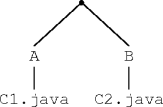
|
Package Scope Example..
$ cat A/C1.java
package A;
class C1 { }
$ cat B/C2.java
package B;
class C2 { }
class C3 {
B.C2 c2;
C2 c3;
A.C1 c1;
}
$
|
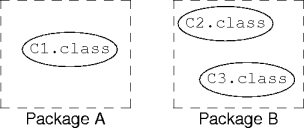
|
Package Scope Example...
$ javac B/C2.java
B/C2.java:8: A.C1 is not public in A;
cannot be accessed from outside package
A.C1 c1;
^
1 error
$
Package Scope Example....
$ cat A/C1.java
package A;
class C1 { }
$ cat B/C2.java
package B;
class C2 { }
class C3 {
B.C2 c2;
C2 c3;
A.C1 c1;
}
$
|
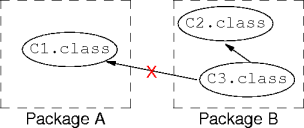
|
Widening Package Scope
- Default package scope is too restrictive.
- Cross-package accesses are essential.
- The public scope for a class (or just public class)
allows access to the class from any package.
- A public class starts with the
public keyword.
- Public scope is a per-class scope, not per-package.
Public Class Naming
- The name of the source file containing a public class must be the same
as the public-class name.
$ cat t.java
public class T { }
$ javac t.java
t.java:1: class T is public,
should be declared in a file named T.java
public class T { }
^
1 error
$
- Only one public class per source file.
Public Scope Example.
$ ls
A B
$ ls A
C1.java
$ ls B
C2.java
$
|

|
Public Scope Example..
$ cat A/C1.java
package A;
public class C1 { }
$ cat B/C2.java
package B;
class C2 { }
class C3 {
B.C2 c2;
C2 c3;
A.C1 c1;
}
$
|

|
Public Scope Example...
$ javac B/C2.java
$
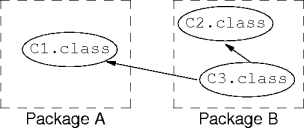
Observations
- A class has either public or package scope.
- All or nothing access is clumsy.
- Package scope is global within the package.
- Every class in the package can access every other class in the
package.
- Problems with this suggest design errors.
- In particular, the package's too big.
The Default Package
- Every
.class file is a member of some package.
$ cat A/C1.java
class C1 { }
$
-
package statements are optional. What package is C1 in?
- Classes not explicitly placed in a package fall into the nameless
default package.
Abbreviating Package Qualification
- Every non-local class access has to be package qualified, which is a
pain.
- The
import statement explicitly locates a class.
import package-qualified-class;
- Imported classes don't need package qualification.
- Identically named classes from different packages still need package
qualification.
Import Example
$ cat B/C2.java
import A.C1;
class C2 { }
class C3 {
C2 c2;
C2 c3;
C1 c1;
}
$ javac B/C2.java
$
|

|
Global Imports
- Import statements of the form
import package.*;
import every public class from the given package.
- There's some documentation value to importing individual classes.
- With a good IDE it doesn't much matter.
-
* imports could lead to unnecessary name clashes.
Mapping Packages
- What is a package in the real world?
- A package maps naturally to directory in a file system.
- Mapping to directories is not required, but is the most conventional
and convenient.
- Package
tetris maps to the directory tetris.
- This mapping is most natural, but not required.
!! Warning !! Warning !!
- As the general semanticists remind: the map is not the territory.
- Do not confuse directories and packages.
- They are different but related things.
- In particular, not every class in a directory is part of the same
package.
-
javac does not check to see that a source file in a package is
being compiled in the proper directory for the package.
Package Mapping Example.
$ ls
A
$ ls A
C1.java
C2.java
$
|
|

|
Package Mapping Example..
$ cat A/C1.java
package A;
class C1 { }
$ cat A/C2.java
class C2 { C1 c1; }
$
|
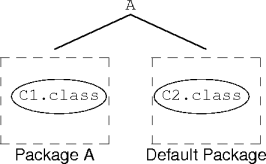
|
Package Mapping Example...
$ javac A/C2.java
A/C2.java:1: cannot find symbol
symbol : class C1
location: class C2
class C2 { C1 c1; }
^
1 error
$
- Even though they share the
A directory, both packages are
separate.
Hierarchical Packages
- Packages nest to form a tree structure.
- Package levels are separated by a dot.
package tetris;
package tetris.player.computer;
- Package hierarchies map naturally to file-system hierarchies.
- The package
tetris.player.computer corresponds
tetris/player/computer (on Unixoid systems).
Imports and Nesting
- Import statements deal with
.class files, not nested packages.
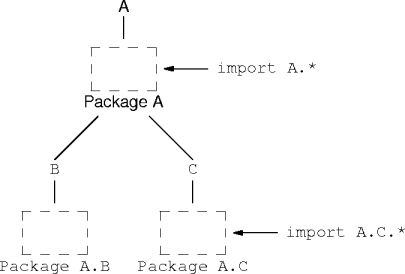
No Really, Where are the Packages?
- Knowing that package X is in directory X isn't too helpful.
- Because where's directory X?
- The classpath describes locations where package directories may
be found.
- It lists parent directories that may contain package directories.
The -classpath Option
-
javac and java have the -classpath command-line option
(also -cp for java) to set the classpath.
- The default classpath is the current directory (
.).
-
javac always searches .; java only by default.
- The classpath is a colon separated list of directories.
- On Unix; check for other systems.
Classpath Example.
$ ls
A B
$ cat A/Ca.java
package Ca;
public class Ca { }
$ cd B
$ cat Cb.java
class Cb { A.Ca ca; }
$
|
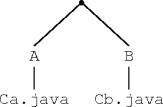
|
Classpath Example..
$ javac Cb.java
Cb.java:1: package A does not exist
class Cb { A.Ca ca; }
^
1 error
$
- Huh? Why doesn't package
A exist?
Classpath Example...
- Classpath defaults to
.
- The search for packages starts in directory
B.
- Classpath needs to point to
B's parent to find A.
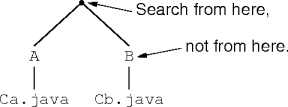
Classpath Example....
$ javac -classpath .. Cb.java
$
The CLASSPATH Environment
- Typing “
-classpath blah” all the time is a pain.
- Unless maybe if you use make or ant.
- You can set the
CLASSPATH environment variable instead.
-
javac and java use the contents of CLASSPATH if
-classpath isn't given.
- Don't forget
. for java if you need it.
Method Scope
- Method scope is independent of class scope.
- By default, methods have package scope.
- Any class in the same package can access the method.
- Methods with public scope can be accessed from any class in any
package.
- Public-scope methods have the
public modifier.
Method Scope Example..
$ cat A/Ca.java
package A;
public class Ca {
public void yes() { }
void no() { }
}
$ cat B/Cb.java
import A.Ca;
class Cb {
void blue() {
Ca ca = new Ca();
ca.yes();
ca.no();
}
}
$
Method Scope Example.
$ javac B/Cb.java
B/Cb.java:7: no() is not public in A.Ca;
cannot be accessed from outside package
ca.no();
^
1 error
$
Private Method Scope
- A method
m with private scope can only be accessed by
features in the same class as m.
- Right now, the only sensible features are other methods.
- No access from other classes in the same package.
- Private-scope methods have the
private modifier.
Instance-Variable Scope
- An instance variable can have public, package, or private scope.
- By default, instance variables have package scope.
- Public or private scope is indicated by the
public or
private modifier.
- Access rules are the same as for methods.
Class and Instance Methods
- By default, methods are called on class instances.
classInstance.method(args...)
- A method manipulates the instance's state, among other things.
- If there's no class instance, there's no method.
- But what about constructors? Where's the instance there?
Class Methods
- A constructor is an example of a class method, a method called
without reference to an instance.
- There's no
this inside a class method.
- A method becomes a class method by using the
static modifier.
static double sin(double x) { ... }
- Static and scope are independent.
Class Method Access
- Class methods are accessed using the name of the containing class:
ClassName.staticMethod(args...)
- Static imports let you drop the class-name prefix.
import static class.staticMethod;
import static class.*;
Class vs. Instance Methods
- Class methods can directly access only other class methods.
- A class method can access instance methods via a class instance.
- Instance methods can directly access class methods.
- Going through the class name is fine too.
Method-Access Example
class blob {
static void m1() { }
void m2() { }
static void m3() {
m1();
blob.m1();
m2();
blob b = new blob();
b.m2();
}
}
Java Programs
- Java programs (as opposed to applets) start executing in the
main
method of the form
public static void main(String args[]) { ... }
Class and Instance Variables
- As with methods, so with variables.
- A variable becomes a class method by using the
static
modifier.
static double pi = 3.1415;
- Static and scope are independent.
- Class and instance methods can access class variables.
Comments
- Comments can either be single line or multi-line.
// Ignore to end of line.
/*
Ignore until next star-slash.
*/
- Multi-line comments do not nest.
- Javadoc comments are multi-line comments of the form
/**
blah blah blah
*/
Javadoc
-
javadoc is a JDK documentation tool.
- It extracts javadoc comments from Java source and formats them as
HTML pages.
|
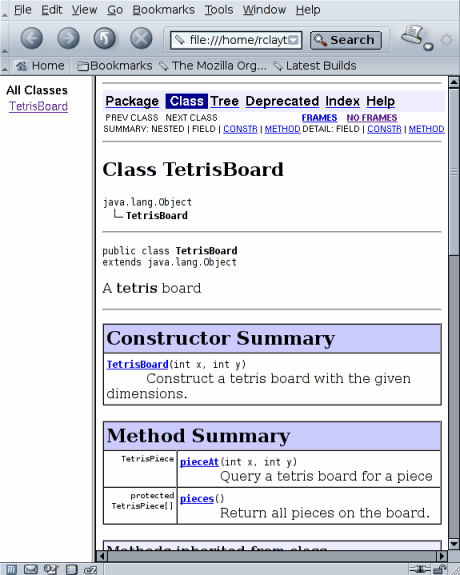
|
Javadoc Comments
- Javadoc comments is text with HTML tags and
@-keywords.
-
javadoc parses @-keywords, passes along HTML.
- Be careful mixing HTML and
@-keywords.
- A feature's javadoc comment immediately precedes the feature.
- Javadoc can document packages, classes, methods, and variables.
Class Comments
- A class comment should immediately precede the related class.
- Useful
@-keywords for classes include @author, @version,
and @deprecated.
- Always document a deprecated feature's replacement.
- By default, only public classes are documented.
Method Comments
- A method comment immediately precede the related method.
- Useful
@-keywords for methods include @param, @returns,
and @throws.
-
javadoc performs sanity checks on these keywords.
- By default, only public and protected methods are documented.
Instance-Variable Comments
- An instance-variable comment immediately precedes the related variable.
- By default, only public and protected instance variables are
documented.
Other Comment Types
- Javadoc also provides package and overview (framework, subsystem)
documentation.
- These comments require separate HTML files.
-
package.html and overview.html
- File placement depends on directory structure.
-
package.html goes in the package directory.
-
overview.html goes in some ancestor directory.
Running Javadoc
-
javadoc's a complicated program, but simple invocations usually
do.
- Make sure you have a separate documentation directory.
-
javadoc generates a lot of files.
- Use the
-d command-line option, or run javadoc in the
documentation directory.
Javadoc Quirks
-
javadoc is a chatty program.
-
javadoc warnings are useful but hard to see.
- Use the
-quiet command-line option to cut the chatter.
- By default,
javadoc documents only public or protected features.
- Use the
-private or -package command-line options to
document more features.
Generalizing Javadoc
- Doclet generalizes
javadoc.
- Create new document components and document formats.
- The trick: generate documentation that's Java code.
- Boilerplate-code generation.
- Used a lot in J2EE systems.
|
This page last modified on 31 January 2008.
|
This work's CC
license.
|



